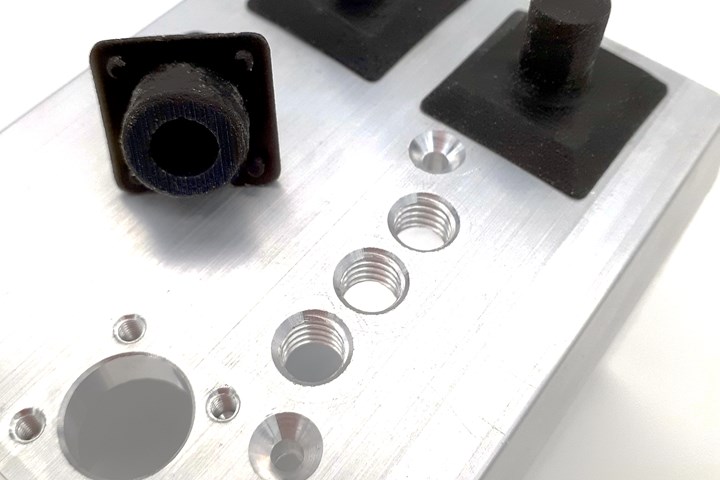
Custom masking solutions can seem daunting and expensive, but they don’t have to be.
Photo Credit: Custom Fabricating & Supplies
Q: When should I consider a custom masking solution vs. an off-the-shelf masking option?
A: There are many suppliers for standard masking options — caps, plugs, and tape. Once you have exhausted those options and the solutions still aren’t there, where do you turn? If time and budget allow, both custom molded rubber and custom die cuts are great options. But what if you are short on time or your order sizes don’t justify the cost for custom tooling?
Featured Content
Custom masking solutions can seem daunting and expensive with long lead times. With today’s technologies, they don’t have to be. If you need a specialized masking option in a short amount of time, there are options available using a converting company that has invested in the latest advancements.
For complex assemblies, ideally, you have an engineered file of the part you want to mask. File extensions would include .stp, .iges and .parasot. Once the mask has been designed by in-house experts, the next step is sampling the design. This provides an opportunity for testing prior to investing in tooling fees.
For molded products, that first sample is often a 3D-printed part. While most 3D printing materials are not designed to withstand the heat and/or chemicals associated with finishing processes, they are helpful to determine basic fit and function. 3D printing has come a long way, and using a high-end 3D Polyjet printer is ideal. PolyJet printers use soluble, gel-like support material, making them capable of very complicated geometries. While they cannot yet print true silicone, they can offer similar materials, tight tolerances, and different durometers (hardnesses) for unparalleled prototyping capabilities.
For many custom tape die-cuts, there exists the opportunity for free samples provided that the material is not a special order. These samples can be produced on a plotter — or digital cutting machine — often the same day they are ordered. Examples of tapes and die cuts that usually can be sampled at no cost include green polyester, crepe tapes and some polyimides. This machine does not require tooling, so it is also ideal for small runs of custom tape die cuts.
For materials such as foam or VHB tapes, plotting is not an option due to their thickness. In this case, there are other dieless sampling options available through flash cutting and laser cutting. Generally, there is some set-up time that is charged, however, it will still be less than standard die charges and there is no waiting for tooling to be manufactured.
When using flash cutting, both sheet and sponge silicone can be easily converted into custom masking in a fraction of the time needed to ramp up with traditional mold tooling. Lead times for production molded parts can easily exceed 20 weeks when looking at a start-to-finish delivery. With flash cutting, everything is produced digitally. Lead times are usually a couple of weeks instead of several months start-to-finish.
Complex shapes can also be achieved through a milling process that some converters have on their flash machines. This allows for 3D shapes to be produced that previously were only achievable through a molding process. To replicate a molded 3D part, layers of material are removed in a process similar to milling a piece of wood or metal. For short production runs, this process can be a game changer, as the expenses for hard tooling can be extensive. The set-up fees for digital production are a fraction of the custom mold costs.
Laser die cutting is another great technology that can be leveraged for rapid prototyping and dieless manufacturing. The laser’s claim to fame is that it can create intricate, tricky patterns that would be difficult, or impossible, for a traditional rotary die-cutting machine to produce. Like flash cutting, laser cutting doesn’t require hard tooling, so it’s ideal if you want to create a quick prototype. This highly repeatable method enables the smallest holes, slots and perforations to be cut with precision. Undesirable material can also be removed from each part through ablation.
Understanding your converting partner’s capabilities can help you adjust lead times and cost expectations. If you need fast and precise, be sure to select a company that has invested in the latest technology. When time is of the essence, don’t get left behind.
About the Author

Christy Schulthess
Christy Schulthess is the marketing director for Custom Fabricating & Supplies. Visit customfabricate.com.
RELATED CONTENT
-
Masking Solutions Provider CFS Dramatically Expands Capabilities and Capacity
Custom Fabrication & Supplies (CFS) completed a new plant expansion packing 10 times the capacity into twice the space. It dramatically enhances the supplier’s custom capabilities to provide extremely precise and cost-effective masking solutions.
-
Coating Systems with the Best Long-Term Performance
The best protection against corrosion and UV exposure, says Axalta’s Mike Withers, is electrocoat and a super durable powder coating.
-
Can You Afford to Not Use Custom Masking?
Are you weighing the costs of a custom masking solution vs. an off-the-shelf solution? Christy Schulthess of Custom Fabricating & Supplies discusses the overall savings that can be realized with custom masking.



















